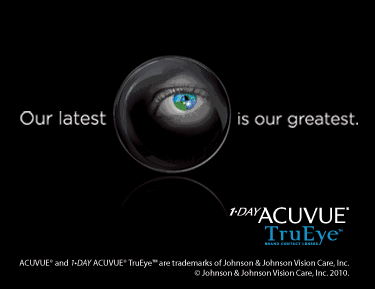 |
B+L Launches PureVision 2 with High Definition Optics
Bausch + Lomb (B+L) announced the launch of PureVision 2 contact lenses with High Definition Optics. Designed to reduce glare and halos while delivering excellent vision, according to the company, these new monthly contact lenses bring together several improvements to help overcome challenges that contact lens wearers face, including spherical aberration.
B+L reports that PureVision 2 optimizes its design to reduce spherical aberration across the entire power range. The lenses are packaged in a unique solution that delivers outstanding comfort upon insertion. Additionally, the new lenses provide high levels of oxygen transmissibility during wear to ensure a healthy environment for the eyes. One of the thinnest lenses available, they are also exceptionally easy to handle.
PureVision 2 is manufactured in balafilcon A (silicone hydrogel) and available in 8.6mm base curve with powers from +6.00D to -12.00D (0.25 steps, 0.50D steps above -6.00D). For more information, click here.
| -- ADVERTISEMENT -- |

|
Barr Receives Schapero Memorial Award
Joseph Barr, OD, MS, FAAO, Vice President, Global Clinical & Medical Affairs and Professional Services, Vision Care, at Bausch + Lomb received the American Academy of Optometry's 2010 Max Schapero Memorial Award at its 88th annual meeting in San Francisco, CA. The award is presented annually to a clinician, researcher or scholar who has made a significant contribution to the cornea and contact lens field by virtue of his/her publications, lectures or research efforts.
Dr. Barr joined B+L in 2007. Prior to joining B+L, Dr. Barr served as Associate Dean for Professional Program and Clinical Services and EF Wildermuth Professor of Optometry at The Ohio State University College of Optometry. He also served as a former editor of Contact Lens Spectrum and the Contact Lens Today weekly newsletter.
Virtual Vision Expo 2010 Debuts
Virtual Vision Expo, an online brand extension of the International Vision Expo & Conference physical trade shows, made its debut last week. In addition to the 25 exhibitor booths and six continuing education sessions, the event featured a virtual lounge for one-to-one chats and peer-to-peer networking and a resource center where attendees can view and download product information, presentations, white papers and e-brochures to a virtual brief case.
All Virtual Vision Expo attendees had a chance to win a trip to New York City in March 2011 to attend International Vision Expo & Conference. Katherine Ly, OD, of Kent Mill Optical, Silver Spring, MD won the trip which includes two night hotel stay and air fare.
Virtual Vision Expo will continue to be available for on-demand viewing until May 1, 2011 and ECPs can view exhibitors and complete the online continuing education and receive the respective accreditation. For more information about Virtual Vision Expo, please visit www.visionexpo.com.
PBA Elects Three New Members to Board
Prevent Blindness America (PBA) announced that Sandra S. Block, OD, Medical Director of School Based Services and Director of School Based Research at the Illinois College of Optometry, Tracy L. Dieterich, Senior Vice President of Wells Fargo Insurance Services USA, Inc. and Michael R. Pender, CPA, Partner at Cavanaugh & Co. LLP, were elected to the Prevent Blindness America Board of Directors.
At the Illinois College of Optometry, Dr. Block has been on the faculty since 1982. Her interests lie in primary eye care for children and persons with disabilities, as well as the process of diagnosis and treatment of visually-related learning problems. She has been a member of both the Public Health and the Scientific Committee and contributed heavily to the children's vision screening protocols for PBA.
Global Specialty Lens Symposium, January 27-30, 2011, Paris Hotel & Casino in Las Vegas

Plan now to attend the Global Specialty Lens Symposium in January 2011. With an expert international faculty and a CE-accredited agenda, the 2011 GSLS will include insightful presentations by experts in the field, hands-on demonstrations of cutting-edge products as well as scientific papers and posters. Look for more detailed information in future issues of Contact Lens Spectrum and online at www.GSLSymposium.com.
--ADVERTISING
AOF and B+L Award Ezell Fellowships
Bausch + Lomb (B+L) and the American Optometric Foundation (AOF) announced the 2010 recipients of the William C. Ezell Fellowships. Recipients are chosen based on excellence in scholarship, research and teaching. In addition to the fellowships, awarded at $8,000 for one year, each Ezell Fellow receives a $750 travel grant to attend the annual meetings of the American Academy of Optometry and the Association for Research in Vision and Ophthalmology.
The recipients of the 2010 Bausch + Lomb Ezell Fellowships are: Kristine Dalton, OD, MSc, MCOptom, Aston University, Birmingham, UK, OTG Research & Consultancy, London, UK, who is studying vision strategy in sports; and Vidhyapriya Sreenivasan, BS Optom, MSc, School of Optometry, University of Waterloo, Canada, who is investigating ocular motor adaptation to lenses and prisms in myopic and emmetropic children.
This month at www.siliconehydrogels.org: Children and contact lenses, myopia progression, use of silicone hydrogels for patients with epidermolysis bullosa, and our synopsis of silicone hydrogels at the 2009 ARVO meeting.
|
 |












